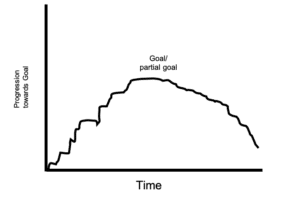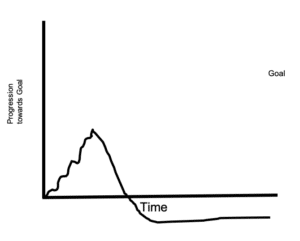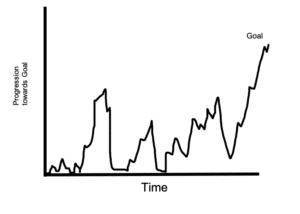If you’re trying to make a change in your behaviour – to eat more healthily, to cut down on snacking, to exercise regularly – your experience is unlikely to be linear. Understanding this helps us to embrace the bumps in the process, and to use the “failures” to our advantage.
It is common for people to be so jaded by trying to change or fearful of trying something new, that they will put up with some deeply uncomfortable situations. This is true of people’s attitudes to their weight and the physical and psychological discomfort they feel; bad relationships that they should get out of but fear the alternatives; jobs people should leave but are uncertain about what else they may be able to do.
People only really change when the pain of staying the same is greater than the perceived pain and uncertainty that accompanies change, OR when there are significant and tangible benefits to change.
Humans are largely wired to avoid change and seek comfort and safety. You are safe and comfortable when you avoid change altogether. However if you think about it, the times that change really works is often when you are uncomfortable, particularly when something bad happens.
A recent example of this is the way businesses were forced to respond to the Coronavirus crisis. Many businesses that would never normally consider doing business solely online were forced to shut up shop and do exactly that. But the key thing to understand is that we don’t need a pandemic to bring about change, if we understand the process of change then we can do it anytime.
There is a tipping point in most situations; there usually comes a time when the discomfort of the situation outweighs the perceived discomfort of change. Once people are in this position, they are ready to change.
It is important that they receive the best support to ensure that this change isn’t superficial but something that will last. The process of successful change is complex, involving relationships, conflict, physical surroundings, work and endless other factors.
Our team at BeeZee Bodies have become skilled at supporting adults and families through this process – but how should you expect it to play out?…
Let’s get graphic…
The following graphs are totally made up! They are my way of showing you what I have learned about what people think change looks like; what it really looks like; what gradual creep back to the norm looks like; and how the ‘what the hell effect’ takes hold!
We set a goal and because we are so motivated to change, it is only a matter of time before our goal becomes a reality… this time. The graph below shows our original optimistic view of how our behaviour change will pan out.
What we think change looks like

During the course of trying to make this change happen we are able to withstand a couple of small setbacks; an unexpected birthday, a takeaway after finishing work really late, etc. However, after a few of these events we relax back into being less focused and gradually we find ourselves back where we started. Sometimes it can be a while before we notice or admit that we have failed to make the changes we set out to.
What ‘creep’ back to the original behaviour looks like

We are able to withstand a couple of setbacks, but once we accept that the effort to change has failed, we let go of the lot! This can lead to us being back where we started or even worse off than when we started – this is what we call the “What the Hell Effect”.
What the ‘What the Hell Effect’ looks like

Changing behaviour in the real world AND getting it to stick is messy! We have to be prepared for lots of unexpected things to happen. Some of these things are out of our control and some are in our control, but we just planned badly, thinking we would always have the level of motivation that we have at the beginning – and this just isn’t normally true! Successful change is the process of learning from mistakes and becoming resilient. Once you realise that success is really about, what it takes to succeed shifts.
What successful change looks like

So get out there. Set a goal to change and set about making it happen. Expect bumps in the road and prepare for them. Good luck, and get in touch if we can help!






